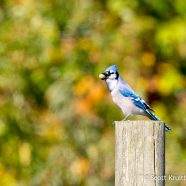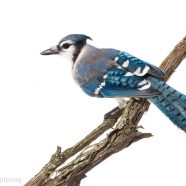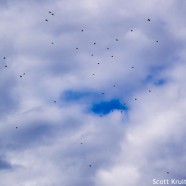Blue Jay End
Speaking of hawks, it appears that I came upon the final remains of a Blue Jay (Cyanocitta cristata) this morning with this very large pile of feathers strewn about under a small tree. The raptor sat here in a relatively quiet spot and plucked its prey, leaving little else behind. I would guess that an accipiter – probably a Cooper’s Hawk, but possibly a Sharp-shinned – took this Blue Jay hours earlier. It may not be the most enjoyable find for some, but it is the cycle of life in nature, and that hawk has to try to survive, too. Scott Kruitbosch Conservation & Outreach...
Read MoreBlue Jay Caching
If this Blue Jay (Cyanocitta cristata) looks a little strange…or lumpy…it is because it was hard at work caching last month. All of those acorns will not store (or plant) themselves! They are said to be able to carry five acorns at a time and store several thousand over a productive fall season. I wonder how many it will be able to remember come winter, and how many will be left after squirrels, chipmunks, other rodents or birds take their share… Scott Kruitbosch Conservation & Outreach Coordinator
Read MoreBlue Jay (Cyanocitta cristata)
So, here’s the deal: if you sneak into our blueberry patch, eat our berries and get yourself caught under the netting, then you have to sit for a few pictures! Blue Jay (Cyanocitta cristata), photographed by RTPI President Twan Leenders for the Meet Your Neighbours global biodiversity project.
Read MoreBlue Jay
This Blue Jay (Cyanocitta cristata) was in the shade on a sunny April day, nevertheless showing off blue hues against a blue sky and flying around with its mate. In this case the blues are not as blue as they could be because they are not actually blue. Huh? Their feather barb cells are specially modified scatter light in a way that makes them appear blue instead of what would be brown melanin, and if this bird flew into the sunlight then it would pop even more. Scott Kruitbosch Conservation & Outreach Coordinator
Read MoreBlue Jay Migratory Flock
Can you identify this flock in the sky? It is an April sighting that you may not expect as so many birds are pushing back to the north, our climate moving into the warm season and the weather improving as each spring day passes. These are all Blue Jays in a sizable group, one of many hundreds of similar flocks that fly over Long Island Sound from points unknown, landing at Stratford Point in Stratford, Connecticut. Sometimes the birds make a brief stop, resting in the trees, before immediately continuing their flight. Other times smaller groups stay and disperse a bit, looking to feed. More...
Read More








